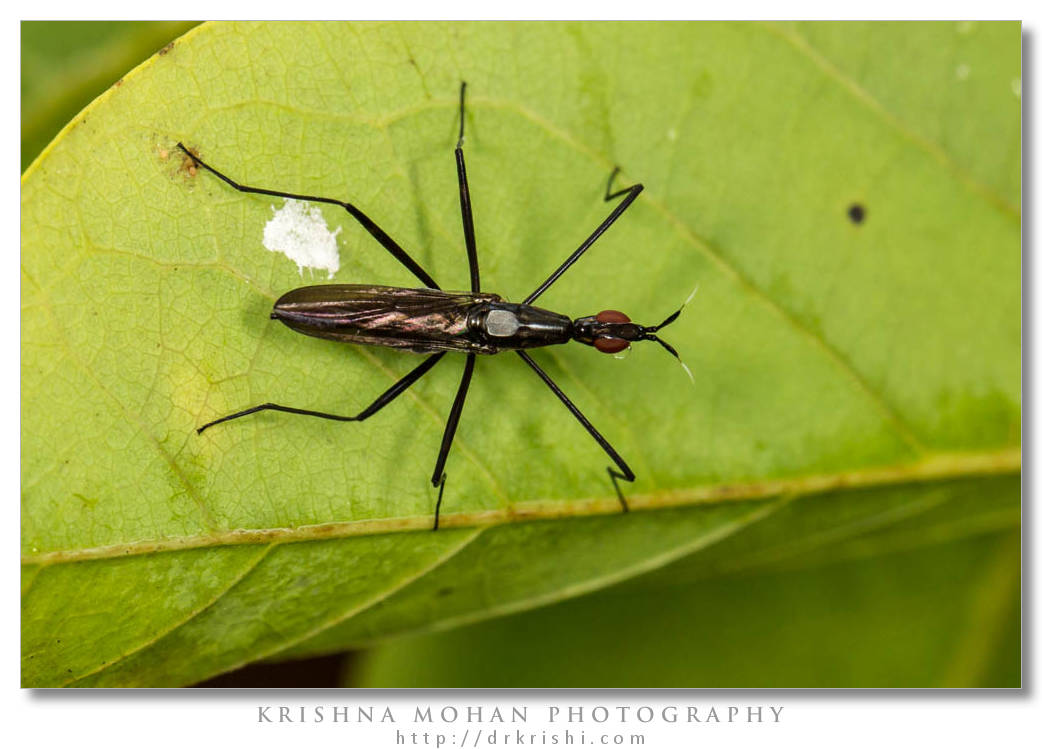
I found this Banana Stalk Fly on our Sugar apple (Annona squamosa) tree in my garden. I was attracted by the flock of insects and butterflies to the rotten Sugar apple. This lonely fly was difficult to capture as it used to disappear behind branches as soon as its big eyes spot my camera. I had to wait for it to finish its meal on the Sugar apple syrup and then only it gave me few good poses. I used Canon EOS 5D Mark III with Canon EF 100 f/2.8L IS USM and Canon MT-24EX macro twin light flash to capture this.

Banana Stalk Fly belongs to Neriidae family of true flies (Diptera) which are closely related to the Micropezidae. Some species of Neriidae are known as cactus flies while others have been called banana stalk flies and the family was earlier treated as subfamily of the Micropezidae which are often called stilt-legged flies. These flies also are confused with similar looking marsh flies or snail-killing flies of Sciomyzidae family because of their long arista and slender legs.

Like the Micropezidae, they have long legs and are found in damp or rotting vegetation where. They however differ in having no significant reduction of the forelegs as seen in the Micropezidae. There are about 100 species in 20 genera. Neriidae are found mainly in tropical regions but there are two North American genera, each with one species, and one species of Telostylinuss occurs in temperate regions of Australia. Very little research has been done on this interesting group of flies.

Banana Stalk Fly are slender, long-legged flies. Telostylinus lineolatus inhabits tropical region, where it aggregates on flowers and rotting fruit. These flies are much smaller than other Neriids, and much less sexually dimorphic, particularly in head shape as compared to rest of the Neriids. Many Neriid species are sexually dimorphic, with males having more elongated bodies, heads, antennae and legs than females. Neriid flies feed on decaying matter (saprophagous). Larvae develop in rotting vegetable matter, including bark and fruit. Adults tend to aggregate on rotting vegetable matter or damaged tree trunks. Adults are also attracted to flowers, or other sources of sugar. Arista is a feature of the Diptera suborder Brachycera. Arista is a simple or variously modified apical or subapical bristle, arising from the third antennal segment. It is the evolutionary remains of antennal segments, and may sometimes show signs of segmentation.The arista in Banana Stalk Fly arises at the tip. The forelegs are long with prominent coxae. The third and fourth veins of the wing converge at the tip and the first vein does not have small bristles or setae.

Males of some species engage in spectacular combat for territory or access to females. The rivals elevate their bodies to an almost vertical posture, and pound each other with the ventral surfaces of their heads, strike each other with their forelegs, or try to place each other in a head-lock. Recent studies have shown that adult body size and shape are extremely sensitive to larval diet in the Australian neriid Telostylinus angusticollis larvae reared in nutrient-rich substrates exhibit greater body size as adults, and males have more elongated bodies, compared to flies reared in nutrient-poor substrates.

As in some fruit flies, neriid larvae in their final instar are capable of skipping. To skip, a maggot bends its body into a ‘C’, grasps its posterior end with its mouth-hooks, tightens the muscles in its body wall, and then releases its hold, causing its posterior end to recoil against the substrate. Although their skipping abilities are not as impressive as those of antler fly (Protopiophila litigata) maggots, neriid maggots can skip distances of 20cm in a single leap.
Thanks to Alessandre for correcting my mis-identification of this banana stalk fly as Gymnonerius sp., not a Telostylinus lineolatus.


Dear Dr. Mohan
very nice photos from yours.
I’m writing you to say that this fly is a Gymnonerius sp., not a Telostylinus lineolatus.
Regards from Brazil.
Thanks Alessandre for the identification. I will add it to the blog.